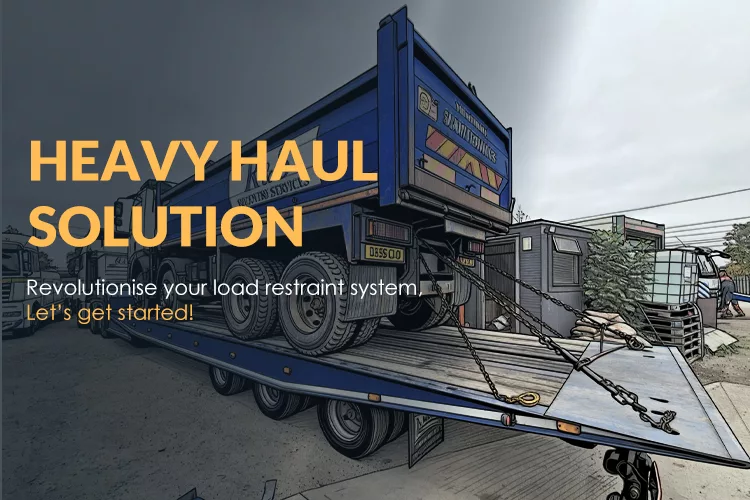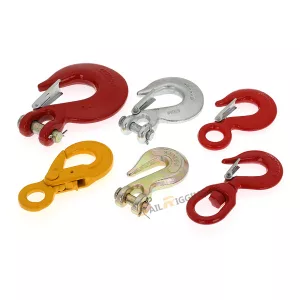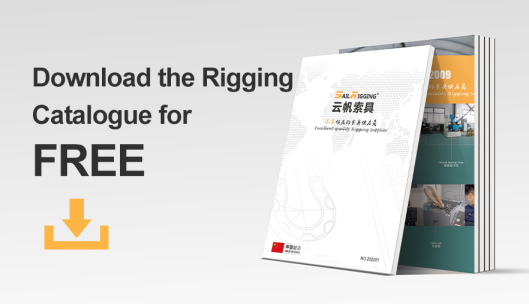Chain And Binders For Heavy Haul Solution
How to safely transport cranes, turbines, and earthmoving equipment? How to ensure the safe transport of oversized items such as large pressure vessels and steel coils? Transporting these large objects by land requires specialized securing equipment; it’s no trivial matter. Large cargo volume means high costs, and any negligence can have serious consequences. Negligence can lead to cargo damage, property loss, and even personal injury. Therefore, heavy transport must use specialized cargo control equipment to ensure that cargo is securely fastened to trailers.
Table of Contents
Transport chains, hooks, and chain ties are indispensable tools for securing cargo. These securing tools are essential in the trucking industry, possessing sufficient strength to secure and transport your heavy goods.
We offer a variety of chains and ties, also known as cargo ties, designed for securing heavy and bulky cargo on flatbed and low-bed trucks, helping you improve transport efficiency and ensure safe cargo transport.
Understanding Chain Ties in Heavy-Duty Applications
The right chain tie is fundamental to the safe and efficient transport of heavy objects. Understanding the differences between chains allows you to choose the appropriate chain to ensure that large, heavy equipment is securely fastened during transport.
Chain Grades
Binding chains are made of durable carbon steel and come with a variety of end fittings, specifically designed for securing heavy cargo. The most common chain grades for securing cargo include Grade 43 (high strength), Grade 70 (transport grade), Grade 80 (alloy grade), and Grade 100 (high-grade alloy grade). Each grade has its unique characteristics; the higher the grade, the greater the strength-to-weight ratio.
Grade 70 transport chains are the industry standard for most heavy-duty binding applications, offering superior performance in terms of strength, weight, and cost.
Common Chain Sizes and Applications
Chain diameters commonly used in heavy-duty applications range from 1/4 inch to 5/8 inch. Larger diameters offer higher workload limits. By considering these factors and selecting the appropriate binding chain size, you can ensure the safe transport of heavy cargo.
| Chain Diameter | Working Load Limit | Main Application |
| 1/4 inch | 3000 lbs | Light heavy-duty loads |
| 3/8 inch | 6600 lbs | Standard Heavy Loads |
| 1/2 inch | 12,000 lbs | Heavy Loads Requiring High Strength Securement |
| 5/8 inch | 18,000 lbs | Extreme Loads or Extreme Conditions |
Different Chain Hooks
Usually binder chains are equiped with hooks. There’re some common chain hooks, eye hook, clevis grab hook, clevis slip hook, S hook, J hook, etc. Also come in different grades, such as G43 and G70.
Working Load Limits
Working load limits refer to the maximum load a chain can withstand under normal operating conditions. A standard working load limit table helps you quickly determine the appropriate chain based on your cargo weight requirements.
According to specific guidelines from the Federal Motor Transportation Safety Administration (FMCSA) for calculating the required number of securing devices, the total working load limit of all securing devices must be at least 50% of the total cargo weight. In other words, if the total cargo weight is 20,000 lbs, then the working load of the securing chain needs to reach 10,000 lbs.
Different chain grades have different working load limits. The higher the grade, the greater the working load limit. A Grade 70 chain is significantly stronger than lower grades such as Grade 43 chains. Grade 100 chains are 25% stronger than Grade 80 chains, while Grade 120 chains are 50% stronger than Grade 80 chains.
Different chain sizes have different working loads. Larger sizes have higher working load limits. For example, with Grade 70 transport chains, the working load limit for a 1/4-inch chain is 3,150 lbs, for a 5/16-inch chain it’s 4,700 lbs, for a 3/8-inch chain it’s 6,660 lbs, for a 1/2-inch chain it’s 11,300 lbs, and for a 5/8-inch chain it’s 15,800 lbs.
Understanding Chain Binders in Heavy-Duty Applications
Chain binders, also known as load binders, are crucial for securing chains around cargo to prevent shifting during transport.
Ratchet load binder and Lever load binder
There’re two common load binders, ratchet load binder and lever load binder. Each has its advantages and is suitable for different applications. Ratchet load binder utilize a ratchet mechanism, allowing for gradual tension adjustment with minimal force. They are safer, easier to operate, and avoid the risk of rebound injuries. Lever load binders are quick to operate and typically have fewer moving parts, but require greater force and are more prone to injury if used improperly.
Choosing the Right Chain Binders for Your Application
When selecting a chain sling type, consider factors such as usage frequency, operator experience, load characteristics, and safety requirements. Regardless of the type chosen, ensure that the sling size matches the chain diameter and that its working load limit matches the chain’s rating. Take US type ratchet load binder as example, the working load limit of 5/16-3/8 is 5400 lbs , are compatible with G43 5/16inch chain, G43 3/8inch chain , and G70 5/16inch chains. The working load limit of 3/8-1/2 inch load binder is 9200 lbs, compatible with G43 3/8inch chain, G43 1/2inch chain, G70 3/8inch chain, and G80 3/8inch chains.
Conclusion
Chains and binders are essential for safe and reliable transportation and are key to preventing accidents in the transport of heavy goods. Ensuring safety requires consideration of factors such as cargo weight, size, and chain grade. Regular inspection of chains, end fittings, and grapples is crucial. If you want to know more information about chain and binder, please contact Sail Rigging.






